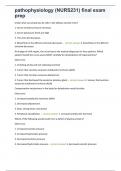pathophysiology (NURS231) final exam
prep
Under what circumstances do cells in the kidneys secrete renin?
1. Serum osmotic pressure increases.
2. Serum potassium levels are high
3. The urine pH decreases.
4. Blood flow in the afferent arteriole decreases. - correct answer 4. blood flow in the afferent
arteriole decreases
At change-of-shift report, the nurse learns the medical diagnoses for four patients. Which
patient should the nurse assess MOST carefully for development of hyponatremia?
Select one:
1. Vomiting all day and not replacing any fluid
2. Tumor that secretes excessive antidiuretic hormone (ADH)
3. Tumor that secretes excessive aldosterone
4. Tumor that destroyed the posterior pituitary gland - correct answer 2. tumour that secretes
excessive antidiuretic hormone (ADH)
Compensation mechanisms in the body for dehydration would include:
Select one:
1. Increased antidiuretic hormone (ADH)
2. Decreased aldosterone.
3. Slow, strong heart contraction
4. Peripheral vasodilation. - correct answer 1. increased antidiuretic hormone
Which of the following would result from a deficit of plasma proteins?
Select one:
1. Increased osmotic pressure
2. Increased hydrostatic pressure
3. Decreased osmotic pressure
4. Decreased hydrostatic pressure - correct answer 3. decreased osmotic pressure
,pathophysiology (NURS231) final exam
prep
Which substance directly controls the reabsorption of water from the collecting ducts?
Select one:
1. Renin
2. Aldosterone
3. Angiotensin
4. Antidiuretic hormone - correct answer 4. antidiuretic hormone
When a patient is receiving diuretic therapy, what best reflects the patient's fluid volume
status?
Select one:
1. Blood pressure and pulse
2. Intake, output, and daily weight
3. Abdominal girth and calf circumference
4. Serum potassium and sodium levels - correct answer 2. Intake, Output and Daily Weight
When is the best time for a patient to receive antidiuretics to reduce the amount of disruption
of their daily routine? - correct answer In the morning
Fatigue is characterized by what 3 things? - correct answer 1. perception of generalized
weakness
2. mental fatigue
3. decreased ability to complete activities
Fatigue is classified as a health problem if it persists for...
a. 1+ week
b. 2+ weeks
c. 3+ weeks
d. one month+ - correct answer b. 2 weeks
There are 3 kinds of fatigue classifications. What are they? - correct answer 1. Unknown
etiology
,pathophysiology (NURS231) final exam
prep
2. Physiological (due to an imbalance in sleep, nutrition and activity)
3. Secondary (due to an underlying health condition)
Fatigue is classified as chronic if it persists for... - correct answer 6+ months
What are some physiological causes of fatigue (not related to health conditions, but
physiological processes themselves) - correct answer 1. buildup of metabolic waste/waste
products in the body
2. inflammatory process
3. an insufficient supply of nutrients needed for functioning
Which fatigue is resistant to treatment: temporary or chronic? - correct answer Chronic
What populations are at the highest risk for fatigue? - correct answer Women, older adults,
and middle-aged adults
2/3 of all chronic fatigue is related to which of the following (choose all that apply):
a. seasonal affective disorder
b. an underlying medical/psychiatric disorder
c. medication side effects
d. isolation/loneliness - correct answer b. 2/3 of all chronic fatigue is related to either the side
effects of medications or an underlying diagnosis (secondary fatigue)
What are interventions for a nursing assessment related to a patient complaining of fatigue? -
correct answer - PQRSTU
- assess the impact on their daily life
- ask them to explain how it feels/subjective data
- observe their general appearance (facial expressions, hygiene)
- palpate lymph nodes and thyroid
- auscultate the lungs and heart
- assess muscle strength against resistance
- perform a cranial nerve assessment
, pathophysiology (NURS231) final exam
prep
- assess deep tendon reflexes
- perform any diagnostic tests (CBC, ESR, renal and liver function, HIV antibodies, thyroid
function and urinalysis)
What are primary prevention techniques for fatigue? - correct answer Balancing sleep and
wakefulness, getting adequate exercise, having a healthy diet, providing patient education for
patients at particular risk for fatigue disorder
What are some interventions a patient can perform to manage fatigue? - correct answer
exercise 30 minutes a day, eat a balanced diet, get adequate sleep, manage any underlying
conditions that can cause fatigue, manage stress with relaxation techniques, have planned
rest/nap breaks, use CNS stimulants if needed, consider CBT psychotherapy, stretch/yoga
regularly, and go for walks.
What is the difference between hypnotics and sedatives? - correct answer Sedatives reduce
excitability but don't cause sleep unless given in high doses.
Hypnotics cause sleep.
What is a long-term side effect of prolonged sedative/hypnotic drug therapy? - correct answer
Interference with REM sleep, daytime drowsiness and fatigue, interruptions of sleep cycles
What is the mechanism of action for benzodiazepines? - correct answer Bind to cell receptors
enhancing the effect of GABA (inhibitory neurotransmitter), which slows the activity of nerves
in the brain
What are the indications for benzodiazepines? - correct answer Commonly used for sedation,
relief of agitation or anxiety, treatment of anxiety-related depression or bipolar disorder, sleep
induction for sleep disorders, skeletal muscle relaxation for muscle spasms, treatment of acute
seizure disorders, treatment and prevention of the symptoms of alcohol withdrawal, and used
as an adjuncts in anaesthesia.
What are the contraindications of benzodiazepines? - correct answer pregnancy, known drug
allergy, open-angle glaucoma, elderly (increases risk of falls and dementia), impaired kidney or
liver function
What can happen if a pregnant woman takes benzodiazepines? - correct answer Increases the
risk of low birth weight babies and preterm delivery
What are the adverse effects of taking benzodiazepines? - correct answer - ataxia (balance,
coordination and speech disturbances)




